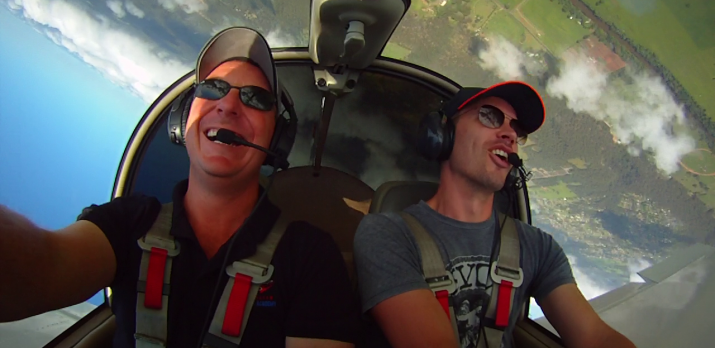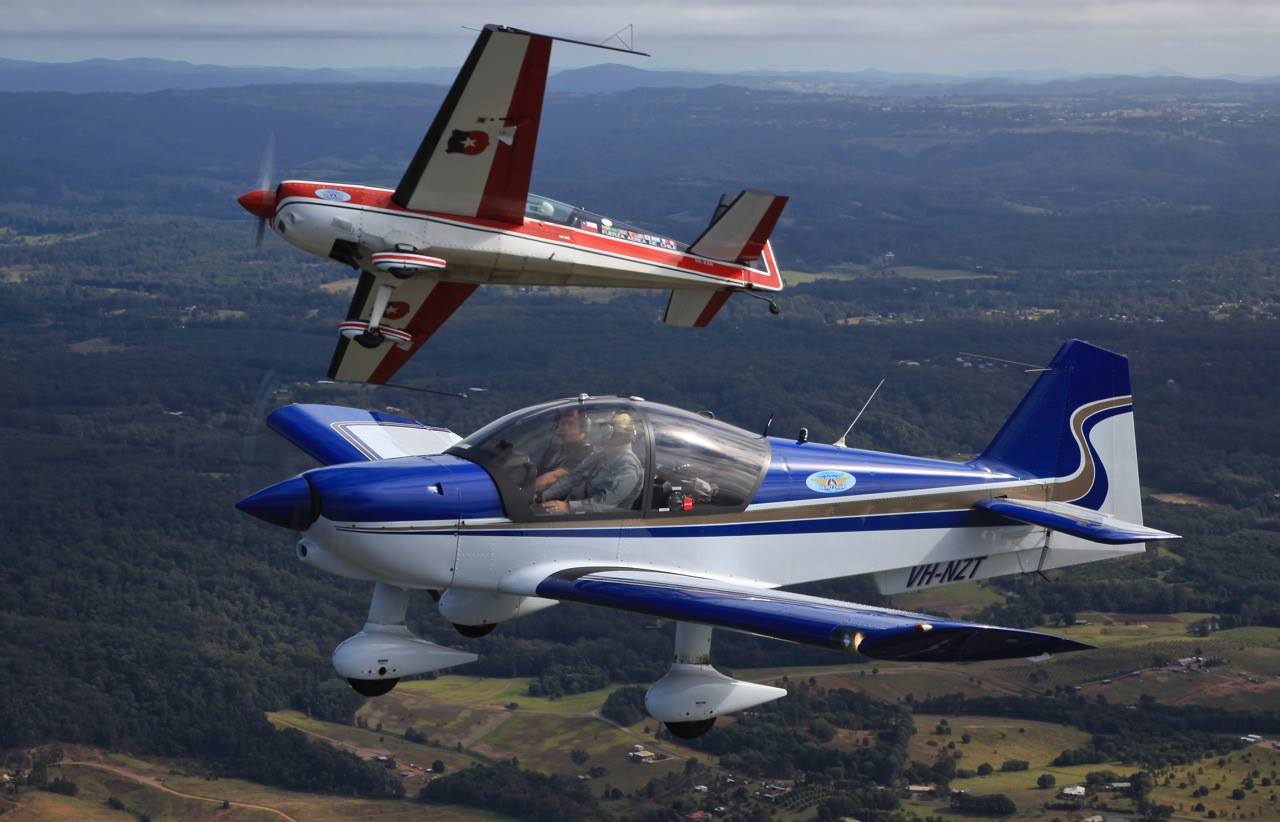FULLY DEVELOPED SPIN RECOVERY TRAINING
GENTLE AEROBATICS!
WHY PILOTS SHOULD LEARN AEROBATICS
 Aerobatics is a key element of the Sunshine Coast Flying School’s training philosophy – Learn why it is so important and why we recommend incorporating it into our intergated RPC + RPL Course and our RPL Conversion Training.
Aerobatics is a key element of the Sunshine Coast Flying School’s training philosophy – Learn why it is so important and why we recommend incorporating it into our intergated RPC + RPL Course and our RPL Conversion Training.
WHAT IS AEROBATICS?
Mention “aerobatics” to most people and it usually conjures up images of spectacular and seemingly dangerous low-level airshow stunts or the Red Bull Air Race. In actual fact, aerobatics is a far more diverse, practical and safety-driven skill.
“Aerobatics” is the art of precisely controlling an aircraft in three-dimensions, using manoeuvres and attitudes not necessary for “normal” flight. Such manoeuvres include loops, rolls, spins and vertical yaw reversals.
There are several aerobatic and 3 dimensional flying disciplines:
- Basic Aerobatics
- Upset Prevention & Recovery Training
- Spin Prevention & Recovery
- Competition Aerobatics
- Airshow or “stunt flying”
AEROBATICS IN BASIC FLIGHT TRAINING
Military pilots are taught basic aerobatics & spinning in initial flight training to develop skill and confidence. Some of the more common aerobatic manoeuvres are based on manoeuvres developed early in air warfare, for example, the barrel roll and the “Immelmann.” Incorporating basic aerobatics into initial flight training exposes pilots to the complete three-dimensional airborne environment early. An aircraft’s limits can then be safely explored and the environment understood without fear of the unknown.
Basic aerobatics and spinning provides pilots with a higher degree of flying precision, confidence and control. This philosophy tends to elude the more “mainstream” civilian flight training organisations for various reasons; the cost and availability of appropriate aircraft and availability of instructors experienced in the art of aerobatic flight.
Our integrated training aims to allow RPC / RPL students to learn basic aerobatics and spinning as they learn to fly, with instructors who are dedicated career professionals experienced in teaching aerobatics.

Confident & complete aircraft control must be ingrained early! The concept of “primacy” is a fundamental of flight training. What is taught first creates a lasting impression. It is often difficult and costly to the student to re-train or “re-wire” the neural connections later.
Aerobatics is NOT just an “advanced” flight training concept! Upset recovery and spinning, if taught at all, are usually optional components in larger organisations’ “advanced” stages of flight training – where it is far too late. By then, the average student has had impressed on them some fairly conservative “limits” in an effort to keep them away from the edges of their aircraft’s performance margins. Rarely is the average student shown the full range of aircraft limits in a controlled environment, or afforded the ability to be shown the result of their mishandling.
Many flight instructors, despite their very honourable intentions, are unfortunately themselves products of a system which has degraded the learning of real flying skill.
Early post-WW2, basic aerobatics and spinning were generally a part of civilian flight training syllabuses. Military training techniques permeated civilian flying schools through ex-military instructors that knew the benefits of this style of training. The result was pilots that knew how to really fly!
Since then, minimum syllabus requirements have changed, which has resulted in an inevitable slide in piloting skill. The newer generations became instructors themselves, without the skill, experience or appropriate aircraft to train higher order “stick and rudder” flying skills – skills which add to safety margins and a deeper understanding of flight.
AEROBATICS IN UPSET RECOVERY TRAINING
Aerobatics is NOT inherently dangerous! There are statistically far more accidents where a “normal” flight manoeuvre has been mishandled. For instance, a pilot may have acted incorrectly, or been inadequately trained to recognise the impending situation, or not recovered in the altitude available.
Loss-of-control in the approach, landing and go-around phases are by far the highest incidence of such events. However, most stall training is conducted at high altitude in level flight – about as far away from most loss-of-control situations as one can get!
Upset recovery training is scenario-based. In our Aerobatic Courses and Advanced Handling Skills courses, we take a normal flight condition and extrapolate it to a simulated loss-of-control event.
Upset recovery is performed in a controlled environment with predictable outcomes. Use of an aerobatic aircraft, with an experienced aerobatic instructor and a thorough briefing of the knowledge and skills required is essential.

Demonstrate & Direct: Precursor conditions are set up, and the event managed step-by-step until loss-of-control occurs. The student has a chance to see the lead-up to the undesired aircraft state and anticipate the outcome and recovery actions.
Monitor: The “startle effect” is also explored, where an unplanned upset is simulated. If the recovery is delayed or mishandled, there is margin to recover safely. It is normal to make mistakes when learning. Near the ground however, mistakes are not an option! Exposure to upset situations and training instinctive, correct recovery actions is VITAL to flight safety.
Upset Recovery training is for ALL pilots! Airlines the world over are beginning to embrace the safety-enhancement that Upset Prevention and Recovery Training provides. Modern airliners have flight-envelope protections systems to enhance safety. For the vast majority of hours flown they work perfectly. However, these protection systems can and do fail – recent accidents such as Air France 447 are testament to this. When they do, the PILOTS must still fly the aircraft using their “stick and rudder” and “aeronautical decision-making” skills.
An aerobatic pilot will:
- have a quicker reaction time to an upset event than those without aerobatic experience, knowing the quickest way back to upright;
- quickly ignore the “startle effect” of the attitudes and sensations involved in a loss-of-control event, having experienced them before;
- demonstrate greater capacity for aeronautical decision-making, being less intimidated by the unusual “picture” outside;
- use appropriate control deflection (full, if warranted) to expedite a return to the desired flight path or to manoeuvre to avoid a collision; and
- be more aware of the aerodynamic limits of the aircraft they are flying and the effects of going beyond them.
In an upset situation, an aerobatic pilot has a recognition and reaction time advantage over those without such training!
COMPETITION & RECREATIONAL AEROBATICS

Competition aerobatics is precision flying at its best! Manoeuvres are carefully planned and executed and there is the challenge in flying the perfect line, angle or degree of roll. Moving across the sky at high speed, coping with G-forces which alternatively try to push you and pull you out of the seat – it’s a real adrenaline rush! It’s fun, it’s safe (there have been ZERO fatalities in Australian aerobatic competition), and it’s a great way to fine tune your flying skills beyond the straight and level! Not unlike figure skating, performing a sequence of aerobatic manoeuvres in front of a panel of judges gives you feedback on how you can improve your performance the next time around. All in pursuit of perfection!
Aerobatics for aviators! Do you enjoy flying purely for the exhilaration of flight and the three-dimensional freedom? Then you’ll LOVE aerobatics! Learning to loop, roll and spin and use the sky as your very own roller-coaster is just awesome fun!
If you’re struggling to stay motivated in your flying and find the expense of longer trips to find new places to fly to a challenge, consider an aerobatic endorsement! Shorter flights, maximum fun!
Aerobatics is all about safety, skill, confidence and precision. Try it! You just might enjoy it a little more than you thought!

With your current level of pilot training, would you be laughing in this situation? (**photo courtesy of Australian Aerobatics Academy)
Learn Aerobatics + Spin Recovery and more!
 The Sunshine Coast Flying School’s Chief Flying Instructor (CFI), Colin Appleton, is one of Australia’s most experienced aerobatics instructors. He holds a CASA Part 61 Instructor Rating, and training endorsements for DF and FA, specialising in Aerobatics, Spin Recovery and Emergency Manoeuvre (EMT) training. He is also a highly experienced Recreational Aviation Australia (RAA) Chief Flying Instructor (CFI) and Instructor Trainer (IT). The Sunshine Cost Flying School offers the most comprehensive advanced pilot skills training courses available in Queensland! Courses include: Recreational Pilot Certificate (RPC), with an easy transition to a CASA Recreational Pilot License (*RPL), Emergency Maneouvre Training, Aerobatics and Spin Recovery. Hit the “Select Course” button for more information and bookings or call us!
The Sunshine Coast Flying School’s Chief Flying Instructor (CFI), Colin Appleton, is one of Australia’s most experienced aerobatics instructors. He holds a CASA Part 61 Instructor Rating, and training endorsements for DF and FA, specialising in Aerobatics, Spin Recovery and Emergency Manoeuvre (EMT) training. He is also a highly experienced Recreational Aviation Australia (RAA) Chief Flying Instructor (CFI) and Instructor Trainer (IT). The Sunshine Cost Flying School offers the most comprehensive advanced pilot skills training courses available in Queensland! Courses include: Recreational Pilot Certificate (RPC), with an easy transition to a CASA Recreational Pilot License (*RPL), Emergency Maneouvre Training, Aerobatics and Spin Recovery. Hit the “Select Course” button for more information and bookings or call us!
- Recreational Pilot Certificate (RPC) Course
- RPC Cross Country, CSU Propeller & Retractable U/C Endorsements
- *RPL conversion & Flight Review Assessment
- Design Feature Endorsements: MPPC, RU, TWUC
- Unusual Attitude Recovery & Emergency Manoeuvre Training
- Aerobatics Endorsement (AERO)
- Low level Aerobatics Endorsements (A150, A100 and A050)
- Upright Spin Recovery Endorsement (SPIN)
- Extra 300 Type Conversion
- “Difficult Tail-dragger’s” – Earn a “real” TWU Endorsement! (Extra300)
- ADF Flight Screening Preparation Course
- Upright and Inverted Spin Recovery Training
- RAAus Instructor Rating
- Aerobatic Competition Coaching (your aircraft or ours!)
* if required CTR and CTA training & endorsements are provided by our Part 141 partners
** With special thanks, SCFS acknowledges that the content of this page has been reproduced from works written by our friends at the Australian Aerobatics Academy .

GOING VERTICAL!

Advanced Aerobatics in our Extra 300



